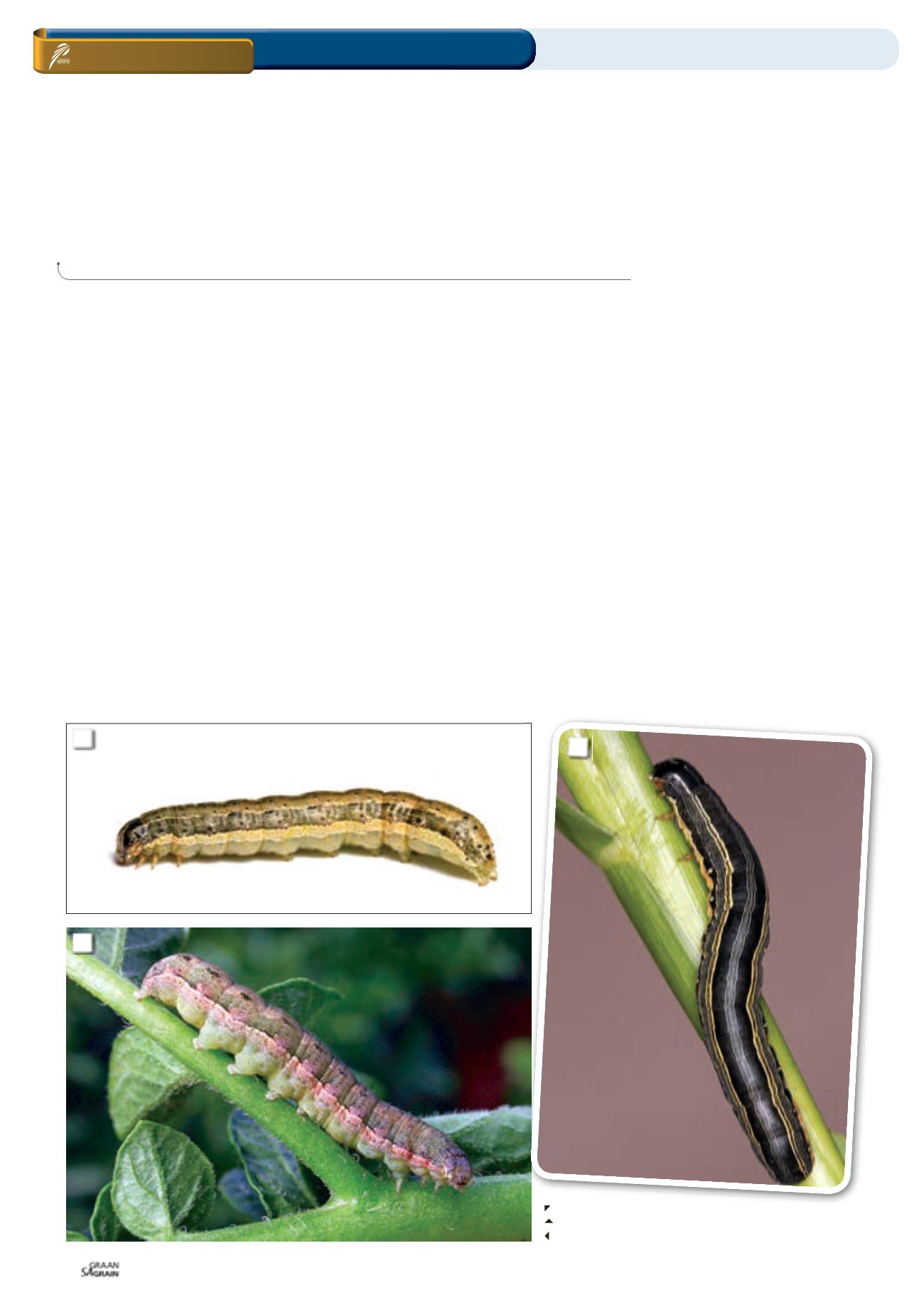

Maart 2017
86
Invasive armyworm species
now also in South Africa
T
he invasive species of armyworm that has invaded Africa,
realised our worst fears when it appeared in South Africa
at the beginning of February. The fall armyworm, which is
common in the USA, not only attacks grain crops, but is also
a well-known pest in groundnuts, cowpeas, cotton, potatoes and
soybeans.
It has been reported since 2016 that a new armyworm species has
appeared on the African continent. The fall armyworm (
Spodoptera
frugiperda
) (
Photo 1
), which is a major pest in various crops in the
USA, has now been reported for the first time in West and Central
Africa, as well as in Zambia, Malawi and Zimbabwe. It also appeared
in South Africa at the beginning of February.
At present we are familiar with two types of armyworms in South
Africa, namely the African armyworm (
Spodoptera exempta
)
(
Photo 2
), and the lesser armyworm (
Spodoptera exigua
) (
Photo 3
).
The African armyworm occurs widely in sub-Saharan Africa and is
a major pest in countries to the north of South Africa. The unex-
pected outbreaks of the pest are characteristic of the African army-
worm. Large areas of grazing, lawns and grass crops (e.g. maize
and sorghum) are seldom attacked by large colonies of larvae.
Small outbreaks occur regularly in high-rainfall areas of Mpuma-
langa and KwaZulu-Natal, but major outbreaks occur only every five
to ten years. The most severe outbreaks in South Africa occur in
seasons with late summer rainfall after drought conditions.
The African armyworm’s moth is brown with white hindwings and
characteristic darker patterns on the forewings. Moths can migrate
across thousands of kilometres, particularly in years with pest out-
breaks. The great migration of moth flights start early in the evening
and moths can achieve an altitude of between 300 m and 1 000 m
above the ground.
Moths move downwind on air currents, usually from hotter, north-
ern neighbouring states like Zambia, Zimbabwe or Mozambique to
South Africa. Moths lay their eggs in clusters of 100 to 400 and a
single female can lay up to 1 000 eggs.
Eggs hatch within three to six days, depending on temperature and
humidity. Larvae become about 25 mm long, appear to be black,
with green/yellow strips down the length of their bodies and have
a characteristic V-shaped mark on the head capsule. Mature larvae
become pupae in the soil.
Armyworm larvae have to be identified timeously for effective
control. If larvae are only observed when they are almost fully
grown, it is usually too late for chemical control, as damage has al-
ready occurred and a second generation will not necessarily appear.
Where larvae are still moving from one field to the next, a furrow
ON FARM LEVEL
Fall armyworm / African armyworm / Lesser armyworm
Integrated pest control
ANNEMIE ERASMUS,
ARC-Grain Crops Institute and
JOHNNIE VAN DEN BERG,
North-West University
1: Fall armyworm (
Spodoptera frugiperda
).
Photo: Matt Bertone
2: African armyworm (
Spodoptera exempta
).
Photo: Diedrich Visser
3: Lesser armyworm (
Spodoptera exigua
).
Photo: Diedrich Visser
1
3
2

















